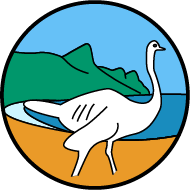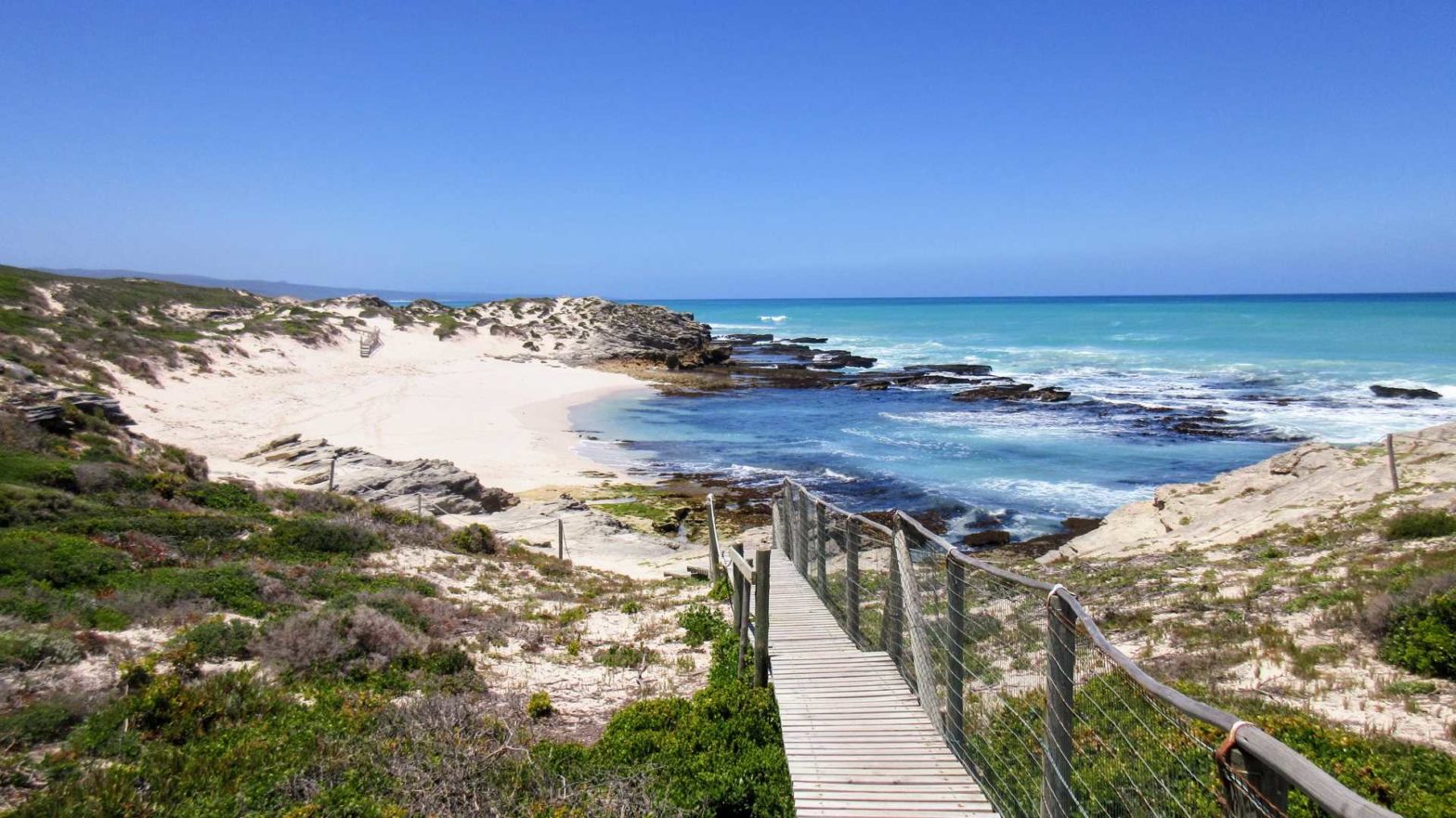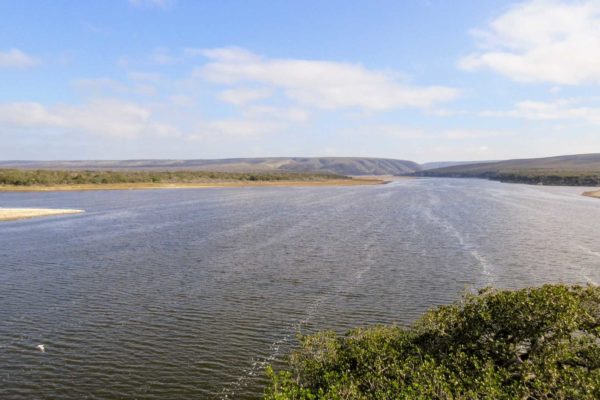By Vicky · Published Jun. 4th, 2021 · Updated Nov. 23rd, 2022
De Hoop Nature Reserve is a real hidden gem in the Western Cape with beautiful scenery, plentiful birds and wildlife and a great campsite. We first visited to run the Whale of Trail Race and loved it so much that we went back a second time.
Page Contents:
Summary
De Hoop is 3 hours drive from Cape Town and I would recommend spending at least two nights to enjoy all it has to offer. If you enjoy birdwatching or want to visit the Potberg section of the park I’d recommend another night or two. We went hiking, running, on a lagoon boat trip, swam at the beach and more. If you need a good road map for this trip, see our recommendations.
How to get to de Hoop
Cape Town to de Hoop Nature Reserve
The route to de Hoop Nature Reserve from Cape Town is through beautiful scenery. The last 40 km, shortly after Bredasdorp, are on a gravel road so it might take longer than Google suggests, especially if you don’t have a 4×4, though the road is good enough for a normal sedan.
Garden Route to de Hoop Nature Reserve
Coming from the Garden Route area to the east, the fastest route is to continue on the N2 past Swellendam before heading south to Ouplaas on a good gravel road just after the Bree Rivier.
Arrive before dark if you can to watch the sunset over the lagoon.
Map of De Hoop Nature Reserve
Accommodation at De Hoop Nature Reserve
Apart from camping (see below) all the other accommodation is quite pricy, though beautifully designed. See here* for rates and detailed descriptions.
Rondavels
The rondavels (max 2 ppl) have great views on the cliffs above a side-arm of the lagoon. For two people these properties are the cheapest at de Hoop by far (apart from the adjacent campsite). They also have some of the best views. Each rondavel has a kettle, small fridge, braai and crockery/cutlery and outdoor table but no other kitchen facilities. There’s a communal kitchen with stoves at the other side of the campsite, or all meals can be bought at the restaurant. Rondavel guests also share communal ablutions.
Cottages in the main area
There are also several cute cottages and suites around the main area. Some are self-catering and some are not. The cottages can accommodate up to six people, while some suites are only for two. Guests here can make full use of the nearby swimming pool and restaurant/bar.
Large cottages/houses across the lagoon
On the other side of the lagoon, you can rent out an entire cottage or a huge manor house for up to eight people. The three places here are a 40-minute drive or a boat trip (weather dependent) from the main Opstal area.
Melkkammer Vlei Cottage
A large, fully-equipped cottage for self-catering on the edge of the lagoon. The cottage takes up to eight guests and has no electricity. It’s a great location for birders.
Melkkamer Foreman’s Cottage
A fully-equipped cottage for self-catering, nestled under milkwood trees. There’s no electricity but a generator is turned on at specific times. Up to six guests can stay here.
Melkkamer Manor House
A lovely, large stone manor, fully equipped for self-catering. There’s no electricity but a generator is turned on at specific times. Up to eight guests can stay here.
The Campsite at De Hoop Nature Reserve
The campsite is on a clifftop overlooking the lagoon. A few of the sites are set further back into the scrub and woodland area but some have great views over the water.
The ablutions are clean and well-maintained and there is a kitchen area which contains stoves, sinks and a huge freezer.
On the De Hoop collection website, the campsites seem to be permanently marked as fully booked, but this is not the case. You cannot book them online but need to phone or email them (details on their own website).
Activities at De Hoop Nature Reserve
See the de Hoop Collection website for a full list of activities. These include:
- Hiking – there are several routes from short to long
- Bird Watching – on the lagoon, at the coast or in the mountains
- Eco Boat Trip – float on the lagoon
- Visit the Beach & Sand Dunes – swimming, birdwatching and taking photos
- Go on a Game Drive – the animals in de Hoop are not scared of cars
- Chill at the Opstal – swim, eat, drink and relax in the main area
- Admire the diverse fauna – don’t miss the plants!
- Visit the Potberg Area – hiking in the mountains and the Vulture Experience
- Walk The Whale Trail – or run this beautiful route
- Other activities – interpretative marine walks, mountain biking, whale watching and stargazing.
1. Hiking at de Hoop
From short strolls to the 55 km Whale Trail (see end of page), there’s something at de Hoop for everyone.
Hikes from Reception
Three easy, flat loops start near the reception. They all start the same way and head along the edge of the lagoon with fabulous views and the opportunity to see many birds. They head back through the wildlife-filled scrub and fynbos at different distances along the lagoon. The shortest is 3 km while the longest is 13.5 km. Read our hike report for the longest, the De Hoop Lagoon Walk (Grebe Trail).
Hikes from Potberg
Two hikes start from the Potberg area (~45-minute drive from Opstal). The 5 km Klipspringer Trail is a circular loop through fynbos, and the more strenuous 10 km out-and-back climb to Potberg Peak has marvellous views.
Hikes from Koppie Alleen (at the coast)
At Koppie Alleen you can hike both ways along the coastline. Heading southwest brings you to the fantastic white sand dunes while turning northeast leads you to many picturesque coves and beaches with abundant opportunities for swimming.
2. Bird Watching in de Hoop Nature Reserve
De Hoop is a paradise for birders since it protects various ecologies all supporting different types of birds. There are three main areas to see different types of birds: 1) the coastline, 2) the lagoon and 3) the mountains. Guided bird walks can be arranged at reception. See their bird checklist here.
At the coastline: 1) Hike the coastal trail northeast from Koppie Alleen (1-5 km) to find all sorts of shorebirds, including Black Oystercatchers. 2) Go on an Interpretative Marine Walk to spot more birds whilst also checking out the tide pools. These guided walks depart one hour before low tide and last roughly two hours. Book in advance.
On the lagoon: 1) Hike one of the three trails starting from near the restaurant (3-13.5 km). These lead along the cliffs above the lagoon where you will see thousands of birds. If you’re lucky you’ll spot night herons and fish eagles amongst many others. 2) Go on an Eco Boat Trip (see below). These boat trips (water level and weather dependent) depart several times a day. Expect to see tens of different species, from pelicans and flamingoes to spoonbills, kingfishers and many more. Book in advance.
In the mountains: 1) Hike the Klipspringer (5 km) or Potberg Trail (10.5 km) while looking out for Cape Vultures, Verreaux Eagles, Peregrine Falcons and more. 2) Go on the guided Vulture Experience. Be led by an experienced guide up to a viewing deck to see Cape Vultures while also looking out for other birds. This trip leaves in the morning and lasts roughly three hours. Pinic included. Book in advance.
3. Eco Boat Trip on the Lagoon
Depending on the water level of the lagoon, 2-hour Eco Boat trips happen twice daily either early morning or early afternoon. We opted for an early morning cruise as apparently, this was the best time for birds. Indeed, we saw thousands of them, plus a few dassies on the rocky shores.
4. At the Beach & Sand Dunes
You can access the beach at Koppie Alleen where there is a small car park. It’s a 12 km drive through the nature reserve from the Opstal area. Make sure to look out for wildlife on the way!
Walking east from the car park
If you head east (left) from the parking area you reach the coastline with cove after cove filled with white sand and the sparkling ocean.
You can hike out and back along the coastline here, go swimming, have a picnic and watch the birds.
Walking west from the car park
If you head west (right) from the parking area you enter an area of white dunes that fall directly into the ocean. It’s a really wild, windswept, beautiful area. You can walk along the coast for roughly 6 km and either return the same way or head around the road back to the car park.
5. Go on a Game Drive
There are many animals in de Hoop Nature Reserve and most of them are very used to humans walking and driving about. Many of the animals – ostriches, eland, mountain zebra, bontebok – are very tame and can be seen easily around the main Opstal area. Others can be seen by driving along the tracks of the reserve.
6. Chill at the Opstal Area
The Opstal Area is the main area where you find check-in, most of the accommodation and campsite, the Fig Tree Restaurant and swimming pool. Additionally, it’s a beautiful place to watch the sunset and sunrise.
7. Admire the Diverse Flora
The vegetation at De Hoop Nature Reserve varies from scrub to coastal sandveld plants and proteas. Head to the coastline to see the sandveld plants, and walk along the trails from reception to see proteas and many scrubland plants.
8. Visit The Potberg Area of de Hoop Nature Reserve
The Potberg section of De Hoop Nature Reserve is a 25 km drive from the main Opstal area with fantastic mountainous scenery, quite different from the rest of the reserve.
The main reasons to visit this mountain area are for hiking or if you go on a guided Cape Vulture experience. The vulture experience departs in the morning and lasts roughly 3 hours, including an hours hike to the vulture viewing deck. This must be booked in advance.
Three hikes depart from here, the 6 km Klipspringer Trail, the more strenuous 10 km out and back climb to Potberg Peak and the multi-day Whale trail.
9. Walk or run the Whale Trail
The Whale Trail is a gorgeous 5-day, 55 km hike in de Hoop Nature Reserve. It starts in the Potberg section through scenic mountains before reaching the beautiful coastline. You need to book a permit online with Cape Nature in advance.
If you’re short of time, another option is to enter the Whale of Trail race and run the route in one day, or as we did, run the shorter 35 km version.
It was a great experience and we ran through the super-diverse landscape, from the mountainous Potberg section to the incredible coastline.
10. Other activities
As well as the above activities, there’s still more! You can go on a guided interpretative marine walk (ask at reception), go mountain biking on the great tracks in the nature reserve, see the whales swimming by (August-October), and at night admire the many stars in the dark skies above.
De Hoop was the first stop on our two-month road trip around South Africa which we wrote up as a book, Chasing Ostriches*. If you enjoyed de Hoop, check out Cape Agulhas National Park slightly further along the coast. For more trip ideas, check out our South Africa Guide.
FAQS: de Hoop Nature Reserve
de Hoop is a 3-hour drive east of Cape Town, on the southern coast of the Western Cape, South Africa.
From Cape Town to de Hoop is a beautiful drive. The last 40 km, shortly after Bredasdorp, are on a gravel road so it might take longer than Google suggests, especially if you don’t have a 4×4, though the road is good enough for a normal sedan. From the Garden Route area to the east, the fastest route is to continue on the N2 past Swellendam before heading south to Ouplaas on a good gravel road just after the Bree Rivier.
de Hoop Nature Reserve is definitely worth visiting. Even though it’s not a national park, I think it’s one of the best places to visit in South Africa for the scenery, wildlife and nature.
de Hoop is a nature reserve managed by Cape Nature. It is not a national park.









I love De Hoop.We came many times with small children and have just been back with grown kids for first time in years.Fabulous time.But we then walked the Klipspringer and are still in recovery 24 hrs later.It is a wonderful fynbos hike but was too strenuous for me.Dont do it unless young or fit .But it was worth it.
I feel secretly proud to have made it as an unfit 68 year old.
This is a beautiful place were at de hoop the first time in 1989 and then a few times in the late 90 s and early 2000 s .
It just became so expensive like most of our wild heritage in SA , a normal human being cant simply not afford it.We are not all from England to come here with a pound and change it into R21.00 .Its a pity that we cannot see our own country its all priced for phorreners ????????????
Hi Leon, I agree with you, it has become expensive, and camping remains the most affordable option.